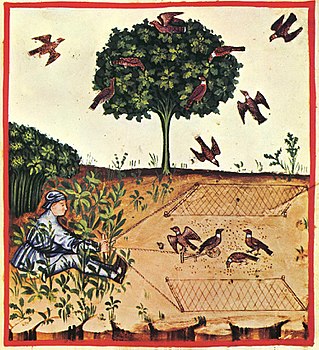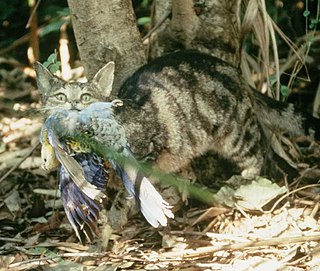
A mousetrap is a specialized type of animal trap designed primarily to catch and, usually, kill mice. Mousetraps are usually set in an indoor location where there is a suspected infestation of rodents. Larger traps are designed to catch other species of animals, such as rats, squirrels, other small rodents, or other animals.

Pest control is the regulation or management of a species defined as a pest; such as any animal, plant or fungus that impacts adversely on human activities or environment. The human response depends on the importance of the damage done and will range from tolerance, through deterrence and management, to attempts to completely eradicate the pest. Pest control measures may be performed as part of an integrated pest management strategy.

A feral cat or a stray cat is an unowned domestic cat that lives outdoors and avoids human contact: it does not allow itself to be handled or touched, and usually remains hidden from humans. Feral cats may breed over dozens of generations and become an aggressive local apex predator in urban, savannah and bushland environments. Some feral cats may become more comfortable with people who regularly feed them, but even with long-term attempts at socialization, they usually remain aloof and are most active after dusk. Of the 700 million cats in the world, an estimated 480 million are feral.

A bird strike is a collision between an airborne animal and a moving vehicle. The term is also used for bird deaths resulting from collisions with structures, such as power lines, towers and wind turbines.

The mountain beaver is a North American rodent. It is the only living member of its genus, Aplodontia, and family, Aplodontiidae. It should not be confused with true North American and Eurasian beavers, to which it is not closely related; the mountain beaver is instead more closely related to squirrels, although its less-efficient renal system was thought to indicate greater relative antiquity for the species. There are seven subspecies of mountain beavers, six of which are found in California and three of which are endemic to the state.
Wildlife contraceptives are contraceptives used to regulate the fertility of wild animals. They are used to control population growth of certain wild animals.

The ecological restoration of islands, or island restoration, is the application of the principles of ecological restoration to islands and island groups. Islands, due to their isolation, are home to many of the world's endemic species, as well as important breeding grounds for seabirds and some marine mammals. Their ecosystems are also very vulnerable to human disturbance and particularly to introduced species, due to their small size. Island groups, such as New Zealand and Hawaii, have undergone substantial extinctions and losses of habitat. Since the 1950s several organisations and government agencies around the world have worked to restore islands to their original states; New Zealand has used them to hold natural populations of species that would otherwise be unable to survive in the wild. The principal components of island restoration are the removal of introduced species and the reintroduction of native species.

Tree squirrels are the members of the squirrel family (Sciuridae) commonly just referred to as "squirrels". They include more than 100 arboreal species native to all continents except Antarctica and Oceania.
Varmint hunting or varminting is the practice of hunting vermin — generally small/medium-sized wild mammals or birds — as a means of pest control, rather than as games for food or trophy. The targeted animals are culled because they are considered economically harmful pests to agricultural crops, livestocks or properties; pathogen-carrying hosts/vectors that transmit cross-species/zoonotic diseases; or for population control as a mean of protecting other vulnerable species and ecosystems.

An animal repellent consists of any object or method made with the intention of keeping animals away from personal items as well as food, plants or yourself. Plants and other living organisms naturally possess a special ability to emit chemicals known as semiochemicals as a way to defend themselves from predators. Humans purposely make use of some of those and create a way to repel animals through various forms of protection.
A rat trap is a trap designed to catch rats. Designs are often larger variations on mousetraps.

Animal trapping, or simply trapping or ginning, is the use of a device to remotely catch an animal. Animals may be trapped for a variety of purposes, including food, the fur trade, hunting, pest control, and wildlife management.

Bird control or bird abatement involves the methods to eliminate or deter pest birds from landing, roosting and nesting.

Urban wildlife is wildlife that can live or thrive in urban/suburban environments or around densely populated human settlements such as townships.
Overpopulation or overabundance is a phenomenon in which a species' population becomes larger than the carrying capacity of its environment. This may be caused by increased birth rates, lowered mortality rates, reduced predation or large scale migration, leading to an overabundant species and other animals in the ecosystem competing for food, space, and resources. The animals in an overpopulated area may then be forced to migrate to areas not typically inhabited, or die off without access to necessary resources.
Population control is the practice of artificially maintaining the size of any population. It simply refers to the act of limiting the size of an animal population so that it remains manageable, as opposed to the act of protecting a species from excessive rates of extinction, which is referred to as conservation biology.

The fauna of Louisiana is characterized by the region's low swamplands, bayous, creeks, woodlands, coastal marshlands and beaches, and barrier islands covering an estimated 20,000 square miles, corresponding to 40 percent of Louisiana's total land area. Southern Louisiana contains up to fifty percent of the wetlands found in the Continental United States, and are made up of countless bayous and creeks.
Integrated pest management in museums, libraries, archives and private collections is the practice of monitoring and managing pest and environmental information with pest control methods to prevent pest damage to collections and cultural property. Preserving cultural property is the ultimate goal for these institutions. The pests come in many different forms: insects, mites, rodents, bats, birds, and fungi and the two most common types are insects and fungi. It is widely recommended that every museum have some form of pest control in place and monitoring system to protect their collection and that museums review their storage and museum facilities to determine how to best control and prevent pest infestations while utilizing an Integrated Pest Management plan.

Cat predation on wildlife is the result of the natural instincts and behavior of both feral and owned house cats to hunt small prey, including wildlife. Some people view this as a desirable phenomenon, such as in the case of barn cats and other cats kept for the intended purpose of pest control; but scientific evidence does not support the popular use of cats to control urban rat populations, and ecologists oppose their use for this purpose because of the disproportionate harm they do to beneficial native wildlife. As an invasive species and superpredator, they do considerable ecological damage.

Deer management is the practice and philosophy of wildlife management employed to regulate the population of deer in an area. The purpose of deer management is to regulate the population's size, reduce negative effects of population on the ecosystem, and maintain the integrity of other populations. Due to economic activity of hunting, deer management can be an important contributor for state and government revenue.
















